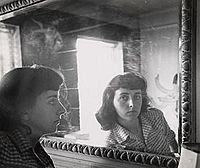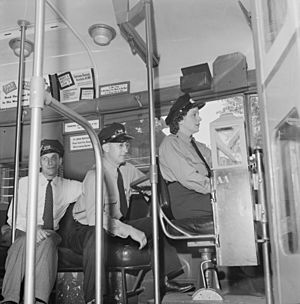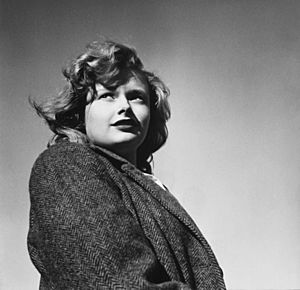Esther Bubley facts for kids
Quick facts for kids
Esther Bubley
|
|
|---|---|

Esther Bubley, self-portrait c. 1950
|
|
| Born | February 16, 1921 |
| Died | March 16, 1998 (aged 77) |
| Occupation | American photographer |
| Spouse(s) | Edwin Locke (Divorced) |
| Parent(s) | Louis and Ida Bubley |
Esther Bubley (February 16, 1921 – March 16, 1998) was an American photographer. She was known for her amazing photos of everyday people and their lives. Esther worked for the U.S. government and her pictures were in many popular magazines.
Life and Career
Esther Bubley was born in Phillips, Wisconsin. She was the fourth of five children. Her parents, Louis and Ida Bubley, were immigrants from Russia.
When Esther was in high school in 1936, a new photo magazine called Life came out. She was really inspired by it. She especially loved the photos from the Great Depression, which showed how hard life was for many people. These pictures were taken by the Farm Security Administration, a government group.
Esther became very interested in photojournalism, which is telling stories with photos. She also loved documentary photography, which means taking pictures to show real life. She even tried to make her high school yearbook look like Life magazine!
After high school, Esther studied for two years at Superior State Teachers College. Then, she went to the Minneapolis School of Art for a year to learn photography.
In 1941, after college, Esther moved to Washington, D.C.. She wanted to find a job as a photographer. When she couldn't find one there, she moved to New York City.
During Christmas 1941, she got a job at Vogue magazine. But she didn't enjoy the work. In early 1942, she went back to Washington, D.C. She got a job working with microfilms at the National Archives and Records Administration.
Later in 1942, a man named Roy Stryker hired her. She became a darkroom assistant at the Office of War Information (OWI). This was a government office that shared information during World War II. Stryker's photo team had just moved there.
With encouragement from Stryker and other photographers, Esther started taking pictures for the OWI. She documented daily life in America during the war. One of her most important projects was a series of photos about bus travel in the Midwest and South.

In late 1943, Roy Stryker left the OWI. He went to work for the Standard Oil Company. Esther went with him, along with other photographers like Gordon Parks.
She created another "Bus Story" series for Standard Oil. This project won an award in 1948 for "Best Picture Sequence." During this time, she was briefly married to Edwin Locke, but they soon divorced.
By 1947, Esther started working on her own more. She began taking pictures for the Children's Bureau. This was a government agency that helped children. Over several years, she took thousands of photos for them. Her work appeared on over thirty covers of their magazine, The Child.
In 1949, Esther won another award for her photo story about mental illness. This story was published in the Ladies' Home Journal magazine. She continued to work for the Ladies' Home Journal. She created many photo stories for their series called "How America Lives."
In 1951, Esther started working as a freelance photographer for Life magazine. Being a freelance photographer means you work for yourself and get hired for different projects. She contributed 40 photo stories to Life, and two of them were even cover stories! Esther was one of the first women to successfully make a living as a freelance photographer for major magazines.
Also in 1951, she took a series of photos at the Pittsburgh Children's Hospital. Edward Steichen, who was in charge of photography at the Museum of Modern Art (MoMA) in New York, liked her work. He showed 13 of her photos from this series in an exhibition in 1952. He even showed her contact sheets to let people see how she chose her best pictures.
Because of this, taking pictures about medical topics became a big part of her work. In 1953, UNICEF and the French government hired her. She traveled to Morocco to photograph a program that treated trachoma, an eye disease that can cause blindness.
Esther entered a photo from this trip into a contest in 1954. She was the first woman to win first place! She even received a trophy that showed a male photographer.
In 1955, Edward Steichen included her work in his famous exhibition called The Family of Man.
In 1956, Pepsi-Cola International hired Esther. She traveled around Latin America to take pictures for their company magazine, Panorama. In the mid-1960s, Pan American World Airways sent her around the world twice! She took photos for their company's collection.
In the late 1960s, Esther started to work less. Photo magazines were not as popular, and she was tired of traveling so much. She spent more time at home in New York City. She worked on projects she loved, like creating two children's books about animals. She also made a book with very close-up pictures of plants, called macro photography.
Esther loved animals very much. She would spend her mornings in Central Park walking her dog. She would take photos and write notes, hoping to make a book about the park. In 1991, the Minneapolis College of Art and Design gave Esther an honorary doctorate degree. She passed away in New York City from cancer on March 16, 1998.
In 2001, an exhibition of Esther's work was shown in New York City. In 2005, a book about her, Esther Bubley: On Assignment, was published. In 2010, the Library of Congress also published a book about her photos.
Selected Exhibitions
Esther Bubley's photographs were shown in many important art shows:
- In and Out of Focus, Museum of Modern Art, New York, NY, 1948.
- Six Women Photographers, Museum of Modern Art, New York, NY, 1950.
- Family of Man, Museum of Modern Art, New York, NY, 1955.
- Esther Bubley, Limelight Gallery, New York, NY, 1956.
- Photographs by Esther Bubley, Phillips Collection, Washington, DC, 1995.
- Esther Bubley: American Photojournalist, UBS Art Gallery, New York, NY, 2001.
Awards
Esther Bubley received several awards for her photography:
- Distinctive Merit, Art Directors Club, 1943.
- First awards from the University of Missouri School of Journalism and the Encyclopædia Britannica, 1948 and 1949.
- Third Prize, Life magazine contest for young photographers, 1951.
- First Prize, Photography Magazine, International Contest, 1954.
- First Award, Art Directors Club, 1958.
- Honorary doctorate, Minneapolis College of Art and Design, 1991.
Books by or about Esther Bubley
- Zoo pals: Big cats, great apes—a look at zoo life, January 1, 1960
- How Puppies Grow, 1971, Millicent E. Selsam (Author), Esther Bubley (Illustrator), ISBN: 978-0-590-40974-2
- How Kittens Grow, 1973, Millicent E. Selsam, ISBN: 978-0-590-07409-4
- A Mysterious Presence: Macrophotography of Plants, text by Percy Knauth, July 1979, ISBN: 978-0-911104-99-8
- Esther Bubley's World of Children in Photographs, June 1982, ISBN: 978-0-8446-5880-3
- Charlie Parker, November 1995, Hank O'Neal (Text), Esther Bubley (Photographer), ISBN: 978-2-85018-223-5
- Esther Bubley: On Assignment, April 2005, Bonnie Yochelson, ISBN: 978-1-931788-57-1
- Fields of Vision: The Photographs of Esther Bubley, March 2010, Amy Pastan (series editor), ISBN: 978-1-904832-48-5
See also
 In Spanish: Esther Bubley para niños
In Spanish: Esther Bubley para niños


